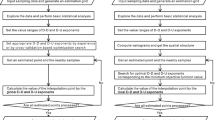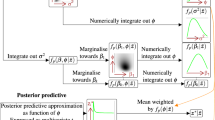Abstract
This work studies how to include both point and areal measurements when estimating gaussian fields by kriging. To achieve this objective, three geostatistical approaches are considered for the areal distributed data: (a) regionalized measurements that are geographically referenced by their centroid as if they were point measurements, (b) regionalized measurements that are explicitly accounted by formally computing all the needed covariances (i.e. area-to-area, area-to-point and point-to-point covariances, respectively) and (c) regionalized measurements that are used as an external drift variable. Results indicate that the measurement error corresponding to the areal data plays a key role to decide when the spatial support of the areal measurements is relevant. For small measurement errors, it is necessary to explicitly consider the spatial support of the areal measurements to avoid large estimation variances. For large measurement errors, the difference between defining areal measurements by using their actual spatial support and defining areal measurements by referencing them by their centroids (i.e. gravity centre) is small. In this situation, it is possible to use the areal measurements as an external drift instead of merging both types of information (i.e. point and areal data) as measurements for kriging. In this case, the cross-validation analysis shows a larger coefficient of determination, similar average kriging variance and smaller mean square error than the obtained in the case of merging point and areal measurements for kriging.









Similar content being viewed by others
References
Baafi EY, Schofield NA (eds) (1997) Geostatistics Wollongong’96, vol 1. Springer, Berlin
Berke O (2004) Exploratory disease mapping: kriging the spatial risk function from regional count data. Int J Health Geogr 3(1):18. doi:10.1186/1476-072X-3-18
Bormann N, Bauer P (2010) Estimates of spatial and interchannel observation-error characteristics for current sounder radiances for numerical weather prediction. I: Methods and application to ATOVS data. QJR Meteorol Soc 136(649):1036–1050. doi:10.1002/qj.616
Bourgault G (1994) Robustness of noise filtering by kriging analysis. Math Geol 26:733–752
Brandes EA, Zhang G, Vivekanandan J (2002) Experiments in rainfall estimation with a polarimetric radar in a subtropical environment. J Appl Meteorol 41:674–685
Chen J, Brissette FP, Leconte R (2011a) Uncertainty of downscaling method in quantifying the impact of climate change on hydrology. J Hydrol 401:190–202
Chen C, Haerter JO, Hagemann S, Piani C (2011b) On the contribution of statistical bias correction to the uncertainty in the projected hydrological cycle. Geophys Res Lett 38:L20403. doi:10.1029/2011GL049318
Chiles JP, Delfiner P (1999) Geostatistics: modeling spatial uncertainty. Wiley, New York
Ciach GJ (2003) Local random errors in tipping-bucket rain gauge measurements. J Atmos Ocean Technol 20:752–759. doi:10.1175/1520-0426(2003)20<752:LREITB>2.0.CO;2
Cohen Liechti T, Matos JP, Boillat JL, Schleiss AJ (2012) Comparison and evaluation of satellite derived precipitation products for hydrological modeling of the Zambezi River Basin. Hydrol Earth Syst Sci 16(2):489–500
Cressie N (1996) Change of support and the modifiable areal unit problem. Geogr Syst 3:159–180
De Marsily G (1986) Quantitative hydrogeology. Academic, San Diego
Deutsch CV, Journel AG (1992) GSLIB: geostatistical software library and user’s guide. Oxford Univ. Press, New York
Dobler C, Hagemann S, Wilby RL, Stötter J (2012) Quantifying different sources of uncertainty in hydrological projections in an Alpine watershed. Hydrol Earth Syst Sci 16:4343–4360. doi:10.5194/hess-16-4343-2012
Garand L, Heilliette S, Buehner M (2007) Interchannel error correlation associated with AIRS radiance observations: inference and impact in data assimilation. J Appl Meteorol 46:714–725. doi:10.1175/JAM2496.1
Gomez-Hernandez J, Journel AG (1993) Joint sequential simulation of multigaussian fields. In: Soares A (ed) Geostatistics TROIA’92. Kluwer, Dordrecht, pp 85–94
Goovaerts P (1997) Geostatistics for natural resources evaluation. Oxford University Press, London
Goovaerts P (2010) Combining areal and point data in geostatistical interpolation: applications to soil science and medical geography. Math Geosci 42(5):535–554. doi:10.1007/s11004-010-9286-5
Goovaerts P (2011) A coherent geostatistical approach for combining choropleth map and field data in the spatial interpolation of soil properties. Eur J Soil Sci 62:371–380. doi:10.1111/j.1365-2389.2011.01368.x
Goovaerts P, Jacquez GM, Greiling D (2005) Exploring scale dependent correlations between cancer mortality rates using factorial kriging and population-weighted semivariograms. Geogr Anal 37(2):152–182. doi:10.1111/j.1538-4632.2005.00634.x
Gotway CA, Young LJ (2004) A geostatistical approach to linking geographically-aggregated data from different sources. Technical report # 2004-012, University of Florida
Gotway CA, Young LJ (2005) Change of support: an inter-disciplinary challenge. geoENV V—Geostatistics for environmental applications. Springer, Berlin, pp 1–13
Habib E, Krajewski WF, Kruger A (2001) Sampling errors of tipping-bucket rain gauge measurements. J Hydrol Eng 6(2):159–166
Habib E, Ciach GJ, Krajewski WF (2004) A method for filtering out raingauge representativeness errors from the verification distributions of radar and raingauge rainfall. Adv Water Resour 27(10):967–980
Habib EH, Meselhe EA, Aduvala AV (2008) Effect of local errors of tipping-bucket rain gauges on rainfall–runoff simulations. J Hydrol Eng 13(6):488–496. doi:10.1061/(ASCE)1084-0699(2008)13:6(488)
Hagemann S, Berg P, Christensen JH, Härter J (2010) Analysis of existing climate model results over Europe. WATCH technical report number 7. http://www.eu-watch.org/media/default.aspx/emma/org/10648756/Technical+Report+Number+07+Analysis+of+existing+climate+model+results+over+Europe+(WB3.2).pdf. Last access 22/04/2015
Journel AG, Huijbregts CJ (1978) Mining geostatistics. Academic Press, London
Koch GS, Link RF (1970) Statistical analysis of geological data. Wiley, London
Kyriakidis P (2004) A geostatistical framework for area-to-point spatial interpolation. Geogr Anal 36(2):259–289
Ledbetter R, Prudhomme C, Arnell N (2012) A method for incorporating climate variability in climate change impact assessments: sensitivity of river flows in the Eden catchment to precipitation scenarios. Clim Chang 113:1–21
Liu Y, Journel AG (2009) A package for geostatistical integration of coarse and fine scale data. Comput Geosci 35(3):527–547
Ma YZ (1993) Comment on application of spatial filter theory to kriging. Math Geol 25(3):399–403
Ma YZ, Royer JJ, Wang H, Wang Y, Zhang T (2014) Factorial kriging for multiscale modelling. J South Afr Inst Min Metall 114:651–657
Merz R, Bloschl G (2005) Flood frequency regionalisation—spatial proximity vs. catchment attributes. J Hydrol 302:283–306
Nagle NN (2010) Geostatistical smoothing of areal data: mapping employment density with factorial kriging. Geogr Anal 42(1):99–117. doi:10.1111/j.1538-4632.2009.00784.x
Pavlik D, Sohl D, Pluntke T, Mykhnovych A, Bernhofer C (2012) Dynamic downscaling of global climate projections for Eastern Europe with a horizontal resolution of 7 km. Environ Earth Sci 65:1475–1482
Piccolo F, Chirico GB (2005) Sampling errors in rainfall measurements by weather radar. Adv Geosci 2:151–155
Roebeling RA, Feijt AJ, Stammes P (2006) Cloud property retrievals for climate monitoring: implications of differences between Spinning Enhanced Visible and Infrared Imager (SEVIRI) on METEOSAT-8 and Advanced Very High Resolution Radiometer (AVHRR) on NOAA-17. J Geophys Res 111:D20210. doi:10.1029/2005JD006990
Samper FJ, Carrera J (1990) Geoestadística: Aplicaciones a la hidrogeología subterránea. CIMNE, Barcelona
Sapriza G, Jódar J, Carrera J, Gupta HV (2013) Stochastic simulation of nonstationary rainfall fields, accounting for seasonality and atmospheric circulation pattern evolution. Math Geosci 45(5):621–645. doi:10.1007/s11004-013-9467-0
Schröter K, Llort X, Velasco-Forero C, Ostrowski M, Sempere-Torres D (2011) Implications of radar rainfall estimates uncertainty on distributed hydrological model predictions. Atmos Res 100(2–3):237–245
Themeßl JM, Gobiet A, Leuprecht A (2010) Empirical-statistical downscaling and error correction of daily precipitation from regional climate models. Int J Climatol 31:1530–1544
Velasco-Forero CA, Sempere-Torres D, Cassiraga EF, Gomez-Hernández J (2009) A non-parametric automatic blending methodology to estimate rainfall fields from rain gauge and radar data. Adv Water Resour 32:986–1002. doi:10.1016/j.advwatres.2008.10.004
Villarini G, Mandapaka PV, Krajewski WF, Moore RJ (2008) Rainfall and sampling uncertainties: a rain gauge perspective. J Geophys Res Atmos 113(D11102):1–12. doi:10.1029/2007JD009214
Wackernagel H (2010) Multivariate geostatistics: an introduction with applications. Springer, Berlin. ISBN:9783642079115
Warr B, Oliver MA, White K (2002) The application of factorial kriging and Fourier analysis for remotely sensed data simplification and feature accentuation. Geogr Environ Model 6(2):171–187
Acknowledgments
This research was undertaken as part of the European Union (FP6) funded Integrated Project called WATCH through Contract Number 036946 and also by the project “Hydrological behaviour analysis of groundwater dependent wetlands”, funded by the Geological Survey of Spain (IGME) with Reference Number CANOA-73.3.00.44.00. Local and cloud computing facilities were provided by Hydromodel Host S.L. which is gratefully acknowledged. We would also like to thank the editor Antonio Paez and three anonymous reviewers for their thoughtful comments and constructive suggestions which led to a substantial improvement of the paper.
Author information
Authors and Affiliations
Corresponding author
Rights and permissions
About this article
Cite this article
Jódar, J., Sapriza, G., Herrera, C. et al. Combining point and regular lattice data in geostatistical interpolation. J Geogr Syst 17, 275–296 (2015). https://doi.org/10.1007/s10109-015-0214-6
Received:
Accepted:
Published:
Issue Date:
DOI: https://doi.org/10.1007/s10109-015-0214-6




